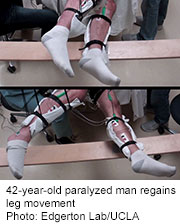
FRIDAY, July 31, 2015 (HealthDay News) — A noninvasive procedure might help people with paralysis move their legs without the need for surgery or implanted devices, new research suggests.
The treatment approach is called transcutaneous stimulation, where a device delivers an electrical current to the spine through electrodes placed on the outside of the lower back.
In a recent trial of the device, five paralyzed men were able to generate steplike movements. The men didn’t walk, but moved while their legs were suspended in braces hung from the ceiling. This enabled them to move without resistance from gravity.
“These encouraging results provide continued evidence that spinal cord injury may no longer mean a lifelong sentence of paralysis, and support the need for more research,” Dr. Roderic Pettigrew, director of the National Institute of Biomedical Imaging and Bioengineering, said in an institute news release.
These findings come on the heels of another successful study using spinal stimulation, but with a surgically implanted electrodes. Electrical stimulation with implanted electrodes allowed the men to voluntarily flex their toes, ankles and knees, and one man was even able to stand unassisted for short periods. The strength and precision of their movements improved over time with intense physical rehabilitation, according to that study, published in April 2014 in the journal Brain.
The latest study, however, focuses on a nonsurgical option.
“The potential to offer a life-changing therapy to patients without requiring surgery would be a major advance; it could greatly expand the number of individuals who might benefit from spinal stimulation. It’s a wonderful example of the power that comes from combining advances in basic biological research with technological innovation,” said Pettigrew.
The current study’s leader, V. Reggie Edgerton, a distinguished professor of integrative biology and physiology at University of California, Los Angeles, expressed similar thoughts.
“There are a lot of individuals with spinal cord injury that have already gone through many surgeries and some of them might not be up to or capable of going through another,” said Edgerton in the news release. “The other potentially high impact is that this intervention could be close to one-tenth the cost of an implanted stimulator.”
The men involved in the study were all paralyzed for at least two years. They underwent a 45-minute transcutaneous stimulation sessions on a weekly basis for about 18 weeks. While undergoing the stimulation, the men were periodically instructed to either try to move their legs or to remain passive.
In addition to the noninvasive stimulation, the men also received several minutes of conditioning. Their legs were moved for them in a steplike pattern.
During the final four weeks of the study, the men were also given the drug buspirone. The medication, which acts like serotonin, has been shown to promote movement in mice with spinal cord injuries.
When the study began, the men’s legs only moved if the stimulation was strong enough to trigger involuntary movements. During therapy, men who tried to move their legs even more developed a significantly wider range of movement, the study found.
After four weeks of both therapy and physical training, the men’s voluntary range of motion doubled while receiving the stimulation. Researchers explained that the treatment worked by reactivating dormant connections between the brain and the spine.
Recordings of electrical signals in the men’s leg muscles increased while the amount of stimulation remained the same, suggesting communication between the brain and spine was being reestablished.
“It’s as if we’ve reawakened some networks so that once the individuals learned how to use those networks, they become less dependent and even independent of the stimulation,” Edgerton said.
By the end of the study, with the medication, the men were able to move their legs with no stimulation at all. On average, their range of motion was the same as when they were moving while receiving stimulation.
Findings from the study were published July 30 in the Journal of Neurotrauma.
The study authors plan to conduct more research to determine if noninvasive spinal stimulation could enable paralyzed patients to bear their own weight the way people with surgically implanted devices can. In addition, they want to investigate if this noninvasive therapy can also help people regain the ability to sweat, regulate blood pressure and control bladder, bowel and sexual function.
The researchers also hope to learn if this external stimulation can help those who are partially paralyzed.
Despite the promise of noninvasive spinal cord stimulation, the researchers said surgically implanted devices may still be needed by some patients.
More information
Learn more about spinal cord injury from the National Institute of Neurological Disorders and Stroke.
Copyright © 2024 HealthDay. All rights reserved.

